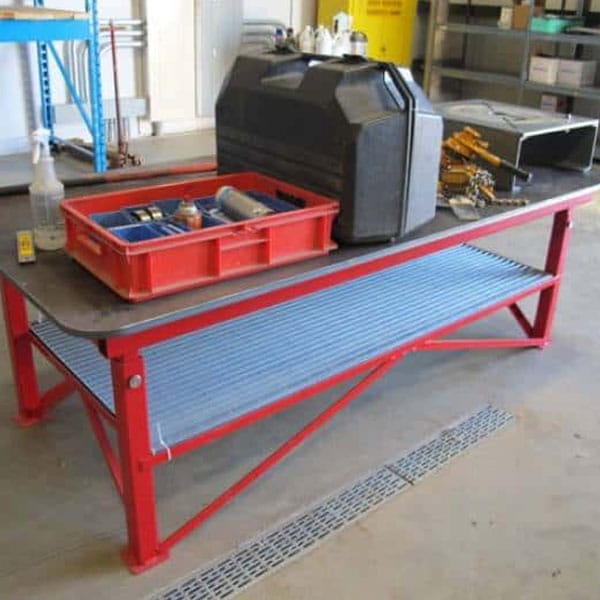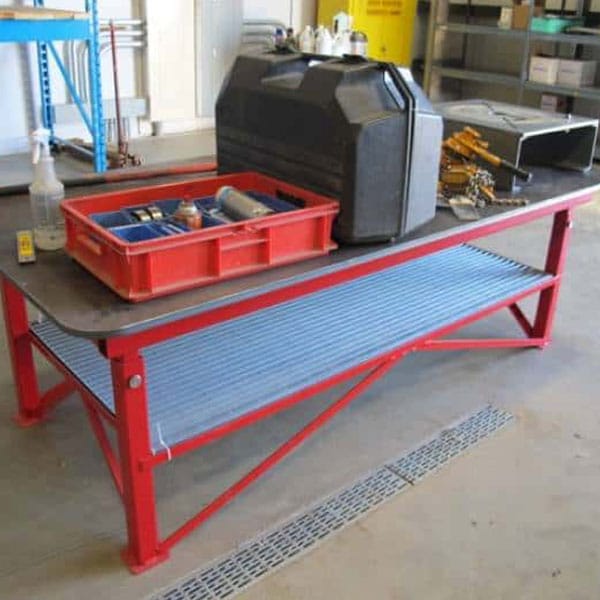When it comes to pursuing the art of welding, a reliable, sturdy welding table is an essential tool that often goes unnoticed. But have you ever wondered why? In this article, we will uncover the purpose behind a welding table and how it plays a crucial role in ensuring successful welding projects. From providing a stable work surface to enhancing safety measures, the welding table proves to be an indispensable companion for welders of all skill levels. So, let’s delve into the world of welding tables and discover the magic they bring to the welding process.
This image is property of www.commander.ca.
Review contents
The Basics of Welding Tables
Overview of welding tables
Welding tables are versatile tools that provide a stable and secure work surface for welding projects. They are commonly used in various industries, including construction, automotive, and manufacturing, where welding is a crucial part of the production process. Welding tables are specifically designed to enhance safety, efficiency, and precision during welding operations. They offer a solid platform for holding and positioning workpieces, allow for easy clamping and fixturing, and provide a space to organize welding tools and accessories. With their durable construction and ability to withstand high heat and spatter, welding tables are essential equipment for welders of all skill levels.
Components of a welding table
A typical welding table consists of several key components that work together to provide an effective welding workspace. The table top is the main working surface, usually made of a durable and heat-resistant material such as steel or cast iron. It provides a sturdy platform for welding projects and is often equipped with built-in measurement markings and precision alignment aids. The table top is supported by a framework or legs, which ensure stability and load-bearing capacity. Additionally, many welding tables come with integrated tool trays and holders, as well as slots or holes for easy organization and storage of welding accessories. Some tables may also have built-in levelers and casters for convenient mobility and adjustment.
Types of welding tables
There are several types of welding tables available on the market, each with its own unique features and advantages. One common type is the traditional fixed welding table, which is a sturdy and permanent fixture in a welding shop or workspace. These tables offer a high level of stability and support, making them ideal for heavy-duty welding tasks. Another popular option is the portable welding table, which is lightweight and easily transportable. Portable tables are often foldable or collapsible, allowing for easy storage and transportation, making them suitable for on-site or mobile welding projects. Some welding tables also come in modular designs that can be customized and expanded with additional accessories and extensions to meet specific project requirements.
Enhancing Safety and Efficiency
Stability and support for welding projects
One of the primary purposes of a welding table is to provide stability and support for welding projects. Welding requires precision and accuracy, and a wobbly or uneven work surface can greatly compromise the quality of the weld. The solid and sturdy construction of a welding table ensures that the workpiece remains securely in place during the welding process, reducing the risk of vibrations or movement. This stability allows welders to work with greater confidence, resulting in improved safety and efficiency.
Heat resistance and protection
Welding involves high temperatures and intense heat, which can quickly damage or warp ordinary work surfaces. However, welding tables are specifically designed to withstand extreme heat and protect both the workpiece and the table itself. The table top is typically made of materials such as steel or cast iron, which have excellent heat resistance properties. This heat resistance not only prevents the table from warping or deforming but also protects the workpiece from heat-related damage. Welding tables may also come with additional heat-resistant coatings or insulation to provide further protection.
Positioning and accessibility
Another key feature of welding tables is their ability to provide optimal positioning and accessibility for welders. The table top is usually at a comfortable working height, allowing welders to maintain proper posture and avoid strain or fatigue during long welding sessions. Additionally, welding tables often have adjustable height and tilt features, enabling welders to find the most ergonomic working position for each project. The table also offers ample space around the workpiece, allowing easy access for welding from multiple angles. This accessibility enhances efficiency and precision, as welders can easily maneuver around the workpiece without any obstructions.
This image is property of www.forsteramerica.com.
Versatility and Flexibility
Multi-purpose work surface
One of the great advantages of welding tables is their versatility as a work surface. While primarily designed for welding, these tables can also be used for various other tasks and projects. The flat and stable table top provides an ideal platform for assembly, fabrication, and other metalworking processes. With the ability to accommodate different types of clamps, vices, and fixturing options, welding tables can be easily adapted to suit a wide range of applications. This multi-purpose functionality makes welding tables a valuable investment for any workshop or workspace.
Adjustability and customization
Welding tables are designed to be highly adjustable and customizable, allowing welders to tailor the workspace to their specific needs and preferences. Many tables feature adjustable height and tilt mechanisms, enabling welders to find the most comfortable and ergonomic working position. Some tables also offer interchangeable table tops, allowing users to switch between different materials or sizes based on the requirements of the project. Furthermore, welding tables often come with a variety of accessory options, such as tool trays, clamps, and holders, which can be positioned and attached as needed. This adjustability and customization ensure that the welding table can adapt to different welding techniques and projects.
Ability to accommodate different welding techniques
Welding encompasses a wide range of techniques, each with its own specific requirements and challenges. The versatility of welding tables allows them to accommodate different welding techniques effectively. For example, tables with precision alignment aids, such as T-slots or grid patterns, can facilitate accurate positioning and alignment of workpieces, which is particularly useful for intricate or complex welding projects. Welding tables also often provide ample space for the use of jigs and fixtures, which are essential for certain welding techniques, such as TIG welding. The flexibility to adapt to different techniques enhances the versatility of the welding table and enables welders to tackle a diverse range of projects.
Precision and Accuracy
Secure clamping and fixturing
Precision and accuracy are critical in welding, and the ability to securely clamp and fixture workpieces is essential for achieving high-quality welds. Welding tables are designed with this in mind, providing a variety of clamping and fixturing options to ensure that workpieces are held firmly in place during welding. Many tables feature pre-drilled holes, T-slots, or grid patterns on the table top, allowing for the easy attachment of clamps, vices, and other fixtures. This secure clamping and fixturing eliminate movement or shifting of the workpiece, resulting in precise and accurate welds.
Lining and alignment aids
To further enhance precision and accuracy, welding tables often come with built-in lining and alignment aids. These aids may include measurement markings, grid patterns, or grooves on the table top to assist in aligning workpieces correctly. Welders can use these markings as references to ensure that their welds are in the correct position and alignment. By providing clear and visible guides, the welding table helps welders achieve consistent and accurate results, minimizing the need for rework or corrections.
Measuring and marking capabilities
In addition to providing lining and alignment aids, welding tables often offer built-in measuring and marking capabilities. Some tables feature rulers, scales, or protractors directly on the table top, allowing welders to take precise measurements and make accurate markings without the need for additional tools. This feature is especially useful when working on projects that require specific dimensions or angles. The ability to measure and mark directly on the welding table eliminates the risk of measurement errors and improves overall welding accuracy.
This image is property of cdn.thefabricator.com.
Durability and Longevity
Materials and construction
Durability and longevity are crucial factors to consider when investing in a welding table. Welding tables are typically constructed using high-quality materials that can withstand the rigors of welding operations. The table top is often made of heavy-duty steel or cast iron, known for their robustness and resistance to warping or deformation under heat and pressure. The framework or legs of the table are also designed to provide maximum stability and load-bearing capacity. Welding tables are built to last, ensuring that they can withstand years of heavy use and continue to provide a reliable and durable workspace.
Resistance to heat and spatter
As mentioned earlier, welding involves high temperatures and the generation of spatter and sparks, which can cause significant damage to ordinary work surfaces. Welding tables are specifically engineered to withstand the heat and spatter associated with welding operations. The materials used in the construction of the table top, such as steel or cast iron, have excellent heat resistance properties and can withstand the intense temperatures produced during welding. Additionally, welding tables are often coated with heat-resistant finishes or equipped with removable heat shields to provide further protection. This resistance to heat and spatter ensures that the welding table remains in optimal condition and extends its lifespan.
Maintenance and care
To prolong the lifespan of a welding table and ensure its continued functionality, proper maintenance and care are essential. Regular cleaning is necessary to remove any welding residue, such as spatter or slag, that may accumulate on the table top. This can be done using a wire brush or other non-abrasive cleaning tools to avoid damaging the table’s surface. After cleaning, it is recommended to apply a thin layer of protective oil or rust inhibitor to prevent the table from rusting or corroding. Additionally, checking for any loose or damaged components and promptly addressing any issues is crucial for maintaining the table’s stability and structural integrity. By following these maintenance guidelines, welders can maximize the durability and longevity of their welding table.
Organization and Tool Storage
Integrated tool trays and holders
Efficient organization and easy access to welding tools and accessories are vital for a smooth and productive welding process. Many welding tables feature integrated tool trays and holders, which provide designated storage spaces for commonly used tools. These trays and holders are typically located on the sides or corners of the table, allowing welders to keep their essential tools within arm’s reach. By having tools readily available and neatly organized, welders can minimize downtime and focus on the task at hand, improving overall efficiency.
Convenient access to welding accessories
In addition to tools, welders often require various accessories during welding operations, such as clamps, electrodes, and welding wire. Welding tables can offer convenient access to these accessories through features such as slots, holes, or hooks. These built-in provisions allow welders to store their accessories directly on the table, ensuring they are easily accessible when needed. This accessibility not only saves time and effort but also reduces the risk of misplacing or losing important welding accessories.
Reduction of clutter and workspace congestion
One of the significant advantages of welding tables is their ability to reduce clutter and congestion in the workspace. By providing dedicated storage spaces for tools and accessories, welding tables help keep the work area organized and free from unnecessary clutter. This organized environment allows welders to have a clear and unobstructed workspace, promoting safety and efficiency. Welding tables with built-in storage solutions also minimize the risk of accidents caused by tripping over tools or materials scattered around the workshop. By keeping everything neatly organized and within reach, welding tables create a more productive and safer working environment.
This image is property of fractory.com.
Additional Features and Accessories
Built-in levelers and casters
Some welding tables come with built-in levelers and casters, which offer additional convenience and functionality. Levelers allow users to adjust the height or tilt of the welding table to suit their desired working position or to compensate for uneven floor surfaces. This adjustability ensures stability and reduces strain on the welder’s body. Casters, on the other hand, provide mobility and ease of transportation. Welding tables equipped with casters can be easily maneuvered around the workshop or relocated to different job sites, eliminating the need for heavy lifting or disassembly. These additional features enhance the versatility and usability of welding tables.
Fume extraction systems
Fumes and gases produced during welding can be hazardous to both the welder and the surrounding environment. Some welding tables come equipped with built-in fume extraction systems to address this concern. These systems consist of integrated fans or vents that help capture and remove welding fumes, ensuring clean air quality in the workspace. By effectively extracting and filtering harmful fumes, welding tables with fume extraction systems contribute to a safer and healthier working environment for welders.
Modular extensions and add-ons
To meet specific project requirements or accommodate unique welding needs, many welding tables offer modular extensions and add-ons. These additions allow welders to customize and expand their welding table to suit their individual preferences and project specifications. Some common modular options include extension panels, additional clamps or fixtures, and accessory racks. By providing the flexibility to adapt and upgrade the welding table as needed, these modular extensions and add-ons enhance the versatility and utility of the workspace.
Choosing the Right Welding Table
Considerations for selecting a welding table
When choosing a welding table, several factors should be taken into consideration to ensure the table meets specific requirements. The size and weight capacity of the table should be assessed based on the types of projects that will be undertaken. It is essential to determine if a fixed or portable table is more suitable for the intended use. Additionally, the material and construction of the table should be evaluated for durability and heat resistance. Welders should also consider the available accessory options, such as clamps, fixtures, and storage compartments, to ensure the table can accommodate their workflow. By carefully considering these factors, welders can select a welding table that is best suited to their needs.
Budget and cost factors
Budget is another crucial factor to consider when choosing a welding table. Welding tables come in a range of prices, depending on their size, features, and quality. It is important to strike a balance between the desired features and the available budget. While it may be tempting to opt for the cheapest option, it is essential to remember that welding tables are long-term investments. Investing in a high-quality, durable table that meets specific requirements can save money in the long run by minimizing the need for repairs or replacements.
Match the table to project requirements
The final consideration when selecting a welding table is to match the table to the specific project requirements. Each project may have unique demands, such as size, weight capacity, or temperature resistance. Understanding the project scope and the expected workload can help determine the ideal table that will provide the necessary stability, functionality, and versatility. By choosing a welding table that aligns with the project requirements, welders can maximize their productivity and ensure high-quality results.
This image is property of weldingtable.in.
Tips for Using a Welding Table
Maintenance and cleaning guidelines
To ensure the longevity and functionality of a welding table, proper maintenance and cleaning are essential. Regular cleaning with a non-abrasive brush and appropriate cleaning agents should be conducted to remove welding residue or debris on the table top. It is important to avoid using abrasive materials or harsh chemicals that may damage the table’s surface. After cleaning, applying a thin layer of protective oil can help prevent rust or corrosion. Additionally, checking for any loose or damaged components and addressing them promptly can prevent further issues. By following these maintenance guidelines, welders can keep their welding table in optimal condition.
Proper welding table setup
Proper setup of the welding table is crucial for achieving accurate and high-quality welds. It is important to ensure that the table is level and stable before starting any welding operations. If the table has adjustable height or tilt features, these should be adjusted to the desired working position. Additionally, checking the clamps, fixtures, or tools being used and ensuring they are securely tightened is essential to prevent any movement or vibrations during welding. Taking the time to properly set up the welding table before starting the welding process will contribute to improved safety and precision.
Safe and effective utilization techniques
Using a welding table safely and effectively is key to a successful welding process. It is crucial to follow all safety guidelines and precautions, such as wearing appropriate personal protective equipment (PPE) and ensuring proper ventilation in the workspace. When working with a welding table, it is important to be aware of the table’s load capacity and not exceed its limitations. Overloading the table can compromise its stability and lead to accidents or damage. Additionally, it is essential to use proper welding techniques and maintain proper body posture to prevent strain or fatigue. By practicing safe and effective utilization techniques, welders can optimize their performance and minimize the risk of injuries.
Conclusion
In conclusion, welding tables are essential tools for any welding operation. They provide a stable and secure work surface that enhances safety, efficiency, precision, and organization. With their versatility, adjustability, and ability to accommodate different welding techniques, welding tables offer a reliable and customizable workspace for welders of all skill levels. The durability and longevity of welding tables ensure that they can withstand the rigors of welding operations and provide reliable support for years to come. Choosing the right welding table involves considering factors such as size, construction, and project requirements. By following proper maintenance and care guidelines and incorporating safe and effective utilization techniques, welders can optimize the performance and lifespan of their welding tables. A welding table is not just a piece of equipment; it is a valuable asset that contributes to the success and quality of welding projects.
































